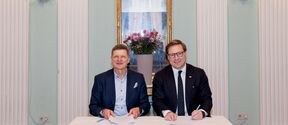Department of Computer Science
We are an internationally-oriented community and home to world-class research in modern computer science.

The Sun’s strong, dynamic magnetic field can catapult huge jets of plasma known as coronal mass ejections (CMEs) out into the solar system. Sometimes these hit Earth, where they can knock out power grids and damage satellites. Scientists don’t fully understand how magnetic fields are generated and amplified inside the Sun, but a study recently published in Nature Astronomy answers one of the fundamental questions about this complex process. By clarifying the dynamics behind solar weather, these findings could help predict major solar events a few days earlier, providing vital extra time for us to prepare.
The Sun’s magnetism comes from a process known as the solar dynamo. It consists of two main parts, the large-scale dynamo and the small-scale dynamo, neither of which scientists have been able to fully model yet. In fact, scientists aren’t even sure whether a small-scale dynamo could exist in the conditions found in the Sun. Addressing that uncertainty is important, because a small-scale dynamo would have a large effect on solar dynamics.
In the new study, scientists at Aalto University and the Max Planck Institute for Solar System Research (MPS) tackled the small-scale dynamo question by running massive computer simulations on petascale supercomputers in Finland and Germany. The joint computing power enabled the team to directly simulate whether the Sun could have a small-scale dynamo.
‘Using one of the largest possible computing simulations currently available, we achieved the most realistic setting to date in which to model this dynamo,’ says Maarit Korpi-Lagg, astroinformatics group leader and associate professor at Aalto University’s Department of Computer Science. ‘We showed not only that the small-scale dynamo exists but also that it becomes more feasible as our model more closely resembles the Sun.’
Some previous studies have suggested that the small-scale dynamo might not work under the conditions found in stars like the Sun, which have a very low magnetic Prandtl number (PrM), a measure used in fluid and plasma physics to compare how quickly variations in the magnetic field and velocities even out. Korpi-Lagg’s research team modeled conditions of turbulence with unprecedentedly low PrM values and found that, contrary to what has been thought, a small-scale dynamo can occur at such low values.
‘This is a major step towards understanding magnetic field generation in the Sun and other stars,’ says Jörn Warnecke, a senior postdoctoral researcher at MPS. ‘This result will bring us closer to resolving the riddle of CME formation, which is important for devising protection for the Earth against hazardous space weather.’
The research group is currently expanding their study to even lower magnetic Prandtl number values using GPU-accelerated code on the new pan-European pre-exascale supercomputer LUMI. Next, they plan to study the interaction of the small-scale dynamo with the large-scale dynamo, which is responsible for the 11-year solar cycle.
Reference: Jörn Warnecke, Maarit J. Korpi-Lagg, Frederick A. Gent, & Matthias Rheinhardt (2023). Numerical evidence for a small-scale dynamo approaching solar magnetic Prandtl numbers. In Nature Astronomy. doi: https://doi.org/10.1038/s41550-023-01975-1
We are an internationally-oriented community and home to world-class research in modern computer science.

Associate Professor Maarit Korpi-Lagg has received funding from the European Research Council to develop a forecasting tool to locate the source regions for the eruption of solar flares already a few days before they emerge on the Sun’s surface.

As a child, Maarit Korpi-Lagg was interested in the stars and coding, and now she researches the activity of the sun, which could not be done without computer science


